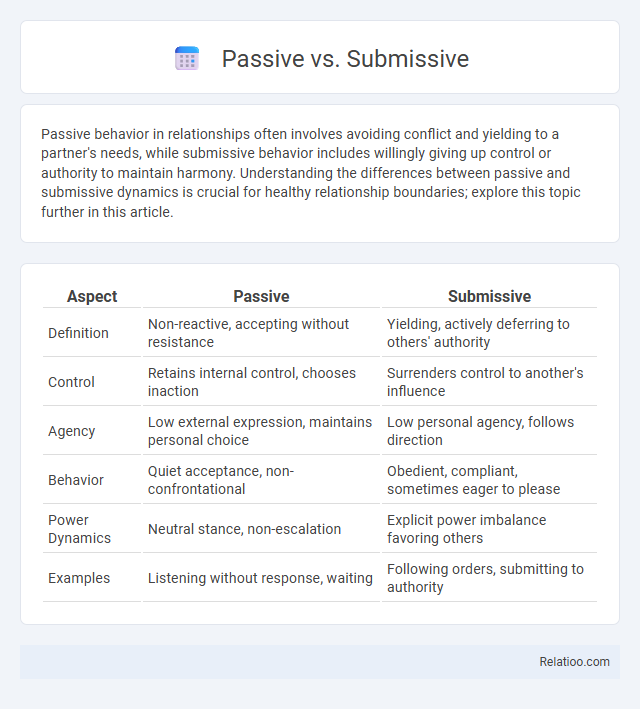Passive behavior in relationships often involves avoiding conflict and yielding to a partner's needs, while submissive behavior includes willingly giving up control or authority to maintain harmony. Understanding the differences between passive and submissive dynamics is crucial for healthy relationship boundaries; explore this topic further in this article.
Table of Comparison
| Aspect | Passive | Submissive |
|---|---|---|
| Definition | Non-reactive, accepting without resistance | Yielding, actively deferring to others' authority |
| Control | Retains internal control, chooses inaction | Surrenders control to another's influence |
| Agency | Low external expression, maintains personal choice | Low personal agency, follows direction |
| Behavior | Quiet acceptance, non-confrontational | Obedient, compliant, sometimes eager to please |
| Power Dynamics | Neutral stance, non-escalation | Explicit power imbalance favoring others |
| Examples | Listening without response, waiting | Following orders, submitting to authority |
Understanding the Difference: Passive vs Submissive
Passive behavior involves a reluctance to assert oneself or take initiative, often to avoid conflict or maintain harmony. Submissive behavior, however, reflects a conscious choice to yield control or authority to others, often out of respect, fear, or a desire to please. Understanding the difference is crucial: passivity denotes inaction or disengagement, while submissiveness implies an active decision to defer to another's will.
Definitions: What Does Passive Mean?
Passive describes a state of accepting or allowing actions without active response, often characterized by non-resistance or lack of initiative. Submissive implies willingly yielding to authority or control, emphasizing compliance and obedience. Passivity refers to a general tendency to remain inactive or disengaged, highlighting a disposition rather than a deliberate choice; understanding these distinctions helps you recognize behaviors in various social or psychological contexts.
Defining Submissive: Key Characteristics
Submissive behavior involves willingly yielding control or authority to another individual, often marked by compliance, deference, and acceptance of guidance or decisions. Unlike passivity, which denotes a general lack of action or resistance, submissiveness is an active choice reflecting trust and respect within a dynamic, often relational context. Understanding your submissive traits can enhance interpersonal relationships by clarifying boundaries and expectations when exchanging power or responsibility.
Psychological Roots of Passivity
Psychological roots of passivity often stem from deep-seated fears, low self-esteem, or learned helplessness, differentiating it from submissive behavior, which involves conscious yielding to others, and passivity, characterized by a general lack of initiative or resistance. Submissive individuals may act out of a desire to avoid conflict or gain approval, while passive individuals might experience internal conflicts that inhibit proactive behavior. Understanding these distinctions can help you recognize underlying emotional patterns and foster healthier coping mechanisms.
The Origins of Submissive Behavior
Submissive behavior originates from evolutionary survival strategies where individuals yielded to dominant figures to avoid conflict or harm, ensuring group cohesion and personal safety. Neuroscientific studies link submissiveness to activation in brain regions associated with social bonding and fear regulation, such as the amygdala and prefrontal cortex. Distinct from passive behavior, which often lacks intentional control, submissiveness involves a conscious or subconscious decision shaped by both genetic predispositions and environmental influences.
Passive vs Submissive in Communication Styles
Passive communication involves avoiding conflict and withholding opinions to maintain peace, whereas submissive communication goes further by yielding to others' demands and often sacrificing personal needs. You might find passive communicators suppressing their views silently, while submissive communicators openly concede, sometimes at the cost of self-respect. Understanding these differences can improve your communication effectiveness and assertiveness in relationships.
Impact on Relationships and Social Dynamics
Passive behavior in relationships often leads to unmet needs and unbalanced dynamics, as individuals may avoid expressing their opinions or desires, resulting in frustration and resentment. Submissive behavior, characterized by yielding to others' control or demands, can create dependency and reduce mutual respect, potentially fostering unhealthy power imbalances. Passivity, a broader trait involving disengagement or lack of response, diminishes active participation in social interactions, weakening communication and hindering the development of strong, reciprocal connections.
Common Misconceptions: Are They the Same?
Passive, submissive, and passivity are often mistakenly used interchangeably, but they hold distinct meanings in psychology and behavior analysis. Passive behavior refers to a lack of assertiveness or action, often to avoid confrontation, while submissive behavior implies yielding to others' authority or control often due to social or power dynamics. Passivity, in contrast, is a broader state of inaction or acceptance without resistance, which can result from various emotional or situational factors and should not automatically be equated with weakness or consent.
How to Recognize Passive and Submissive Traits
Passive traits often involve a reluctance to assert oneself or make decisions, while submissive traits include yielding to others' authority or control. You can recognize passive behavior by observing a tendency to avoid conflict and defer choices, whereas submissiveness is marked by compliance, obedience, and prioritizing others' demands over personal needs. Understanding these distinctions helps identify whether someone is simply passive or actively submitting in social or interpersonal contexts.
Personal Growth: Moving Beyond Passivity or Submission
Moving beyond passivity or submission is essential for your personal growth, as passivity often leads to missed opportunities and lack of self-advocacy, while submissiveness may result in compromised boundaries and diminished self-worth. Embracing assertiveness empowers you to take control of your decisions and fosters resilience, promoting a balanced self-expression that respects both your needs and others'. Developing this skill enhances emotional intelligence and strengthens your overall well-being.

Infographic: Passive vs Submissive
 relatioo.com
relatioo.com